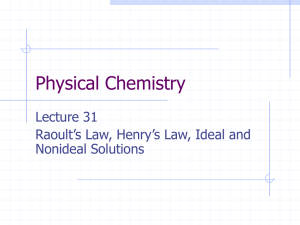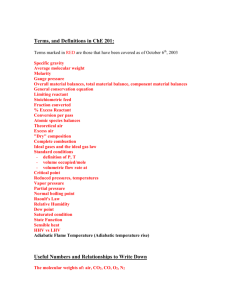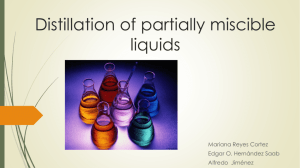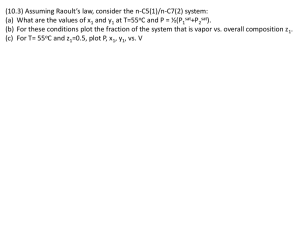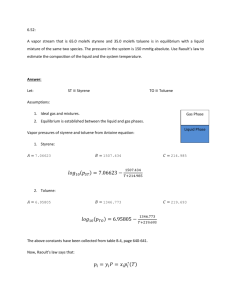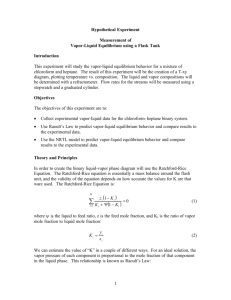Physical Chemistry Lecture 32 Ideal and Nonideal Solutions
advertisement
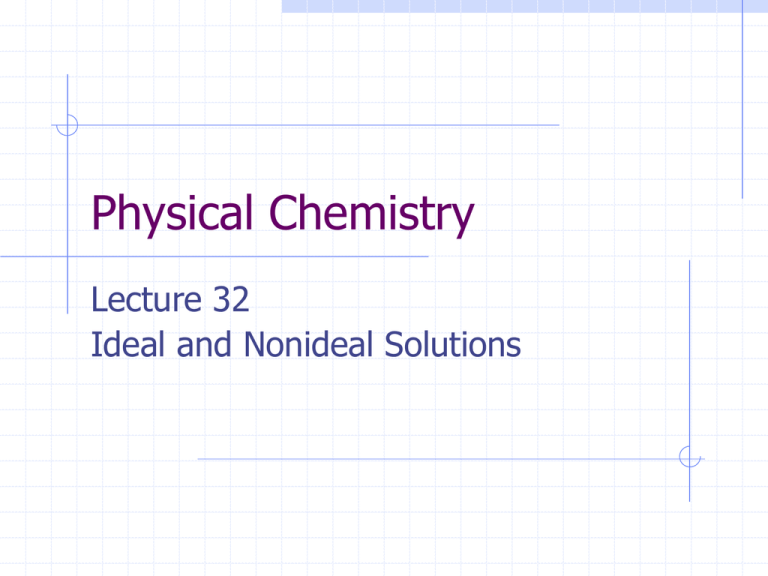
Physical Chemistry Lecture 32 Ideal and Nonideal Solutions Activities and ideal solutions Activity and concentration of a liquid solution related by activity coefficient Ideal solution properties sensitive to concentration as they change statistically For ideal solutions γi = 1 ai , liq = γ X ,i X i ai , liq = γ c ,i ci ciθ = γ m ,i mi miθ ai , liq Raoult’s law in the idealsolution limit Activity determined by statistics No differential energies of interaction between components Activities in the solution and the gas are related Gives a relation between solution concentration and gas partial pressure Total pressure linear in mole fraction P1 = X 1,liq P1• P2 = X 2,liq P2• P = P1 = P1• + P2 + ( P2• − P1• ) X 2 Ideal-solution example: SiCl4 and CCl4 Almost ideal solution Comes close to obeying Raoult’s law for an ideal solution Molecules are quite similar in structure Replacing SiCl4 by CCl4 does not change the energy structure significantly To be nearly ideal, the partners must be very similar in structure and intermolecular interactions Negative deviations: Acetone-chloroform solutions Deviation from the ideal Raoult law is negative Molecules prefer to be in solution ΔmixingGexcess < 0 Strong attractive forces between components γ<1 Positive deviations: CCl4-CH3OH solutions Deviations from ideal Raoult’s law are positive Molecules prefer to be in the gas phase above what is expected statistically ΔmixingGexcess > 0 Strong repulsive forces between the components γ<1 Regular-solution theory Attempt to model deviations from ideal solution Additional chemical-potential term proportional to X2 Deviations determined by interaction energy, due to differences in coupling between like and unlike molecules Activity coefficients determined by interaction energy and concentration µ1 (T , X 1 ) = µ1ideal (T ) + wX 22 µ 2 (T , X 2 ) = µ 2ideal (T ) + wX 12 w = 2ε12 wX 22 γ 1 ( X 1 , T ) = exp RT wX 12 γ 2 ( X 2 , T ) = exp RT 2 γ ( X ) 1.5 1 0 0.2 0.4 0.6 X 0.8 − ε11 − ε 22 1 Regular-solution interaction energies Interaction energies range from positive to negative values Typical magnitude of 100-1000 joules w is temperaturedependent Only approximates real behavior Solution T/K w/J CCl4-Benzene 298 324 Cyclohexane-Benzene 293 1275 Cyclohexane-CCl4 313 267 Benzene-toluene 353 -41 Carbon disulfide- acetone 308 4175 Summary Raoult’s law (based on mole fractions) applies to an ideal solution Ideal solutions result from mixing two similar materials Most solutions are not ideal Positive and negative deviations from Raoult’s law determined by the nature of interactions Regular-solution theory – attempt to model the deviations from Raoult’s law with a simple correction term in the chemical potential
